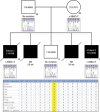Prenatal growth restriction, retinal dystrophy, diabetes insipidus and white matter disease: expanding the spectrum of PRPS1-related disorders
- PMID: 24961627
- PMCID: PMC4326708
- DOI: 10.1038/ejhg.2014.112
Prenatal growth restriction, retinal dystrophy, diabetes insipidus and white matter disease: expanding the spectrum of PRPS1-related disorders
Abstract
PRPS1 codes for the enzyme phosphoribosyl pyrophosphate synthetase-1 (PRS-1). The spectrum of PRPS1-related disorders associated with reduced activity includes Arts syndrome, Charcot-Marie-Tooth disease-5 (CMTX5) and X-linked non-syndromic sensorineural deafness (DFN2). We describe a novel phenotype associated with decreased PRS-1 function in two affected male siblings. Using whole exome and Sanger sequencing techniques, we identified a novel missense mutation in PRPS1. The clinical phenotype in our patients is characterized by high prenatal maternal α-fetoprotein, intrauterine growth restriction, dysmorphic facial features, severe intellectual disability and spastic quadraparesis. Additional phenotypic features include macular coloboma-like lesions with retinal dystrophy, severe short stature and diabetes insipidus. Exome sequencing of the two affected male siblings identified a shared putative pathogenic mutation c.586C>T p.(Arg196Trp) in the PRPS1 gene that was maternally inherited. Follow-up testing showed normal levels of hypoxanthine in urine samples and uric acid levels in blood serum. The PRS activity was significantly reduced in erythrocytes of the two patients. Nucleotide analysis in erythrocytes revealed abnormally low guanosine triphosphate and guanosine diphosphate. This presentation is the most severe form of PRPS1-deficiency syndrome described to date and expands the spectrum of PRPS1-related disorders.
Figures




Similar articles
-
Expanding the phenotype of PRPS1 syndromes in females: neuropathy, hearing loss and retinopathy.Orphanet J Rare Dis. 2014 Dec 10;9:190. doi: 10.1186/s13023-014-0190-9. Orphanet J Rare Dis. 2014. PMID: 25491489 Free PMC article.
-
Missense variants in the X-linked gene PRPS1 cause retinal degeneration in females.Hum Mutat. 2018 Jan;39(1):80-91. doi: 10.1002/humu.23349. Epub 2017 Oct 17. Hum Mutat. 2018. PMID: 28967191
-
X-linked Charcot-Marie-Tooth disease, Arts syndrome, and prelingual non-syndromic deafness form a disease continuum: evidence from a family with a novel PRPS1 mutation.Orphanet J Rare Dis. 2014 Feb 14;9:24. doi: 10.1186/1750-1172-9-24. Orphanet J Rare Dis. 2014. PMID: 24528855 Free PMC article.
-
Association of PRPS1 Mutations with Disease Phenotypes.Dis Markers. 2015;2015:127013. doi: 10.1155/2015/127013. Epub 2015 May 24. Dis Markers. 2015. PMID: 26089585 Free PMC article. Review.
-
PRPS1 mutations: four distinct syndromes and potential treatment.Am J Hum Genet. 2010 Apr 9;86(4):506-18. doi: 10.1016/j.ajhg.2010.02.024. Am J Hum Genet. 2010. PMID: 20380929 Free PMC article. Review.
Cited by
-
Common and rare forms of diabetes mellitus: towards a continuum of diabetes subtypes.Nat Rev Endocrinol. 2016 Jul;12(7):394-406. doi: 10.1038/nrendo.2016.50. Epub 2016 Apr 15. Nat Rev Endocrinol. 2016. PMID: 27080136 Review.
-
A novel mutation in gene of PRPS1 in a young Chinese woman with X-linked gout: a case report and review of the literature.Clin Rheumatol. 2020 Mar;39(3):949-956. doi: 10.1007/s10067-019-04801-0. Epub 2019 Nov 26. Clin Rheumatol. 2020. PMID: 31773495 Review.
-
Phosphoribosyl pyrophosphate synthetase 1 (PRPS1) associated retinal degeneration: an international study.Ophthalmic Genet. 2025 Apr;46(2):133-143. doi: 10.1080/13816810.2024.2444619. Epub 2025 Jan 6. Ophthalmic Genet. 2025. PMID: 39763288
-
Complex Patterns of Association between Pleiotropy and Transcription Factor Evolution.Genome Biol Evol. 2016 Oct 23;8(10):3159-3170. doi: 10.1093/gbe/evw228. Genome Biol Evol. 2016. PMID: 27635052 Free PMC article.
-
Expanding the phenotype of PRPS1 syndromes in females: neuropathy, hearing loss and retinopathy.Orphanet J Rare Dis. 2014 Dec 10;9:190. doi: 10.1186/s13023-014-0190-9. Orphanet J Rare Dis. 2014. PMID: 25491489 Free PMC article.
References
-
- Becker MA. Phosphoribosylpyrophosphate synthetase and the regulation of phosphoribosylpyrophosphate production in human cells. Prog Nucleic Acid Res Mol Biol. 2001;69:115–148. - PubMed
-
- Arts WF, Loonen MC, Sengers RC, Slooff JL. X-linked ataxia, weakness, deafness, and loss of vision in early childhood with a fatal course. Ann Neurol. 1993;33:535–539. - PubMed
-
- Roessler BJ, Nosal JM, Smith PR, et al. Human X-linked phosphoribosylpyrophosphate synthetase superactivity is associated with distinct point mutations in the PRPS1 gene. J Biol Chem. 1993;268:26476–26481. - PubMed
Publication types
MeSH terms
Substances
Grants and funding
LinkOut - more resources
Full Text Sources
Other Literature Sources
Medical
Molecular Biology Databases

